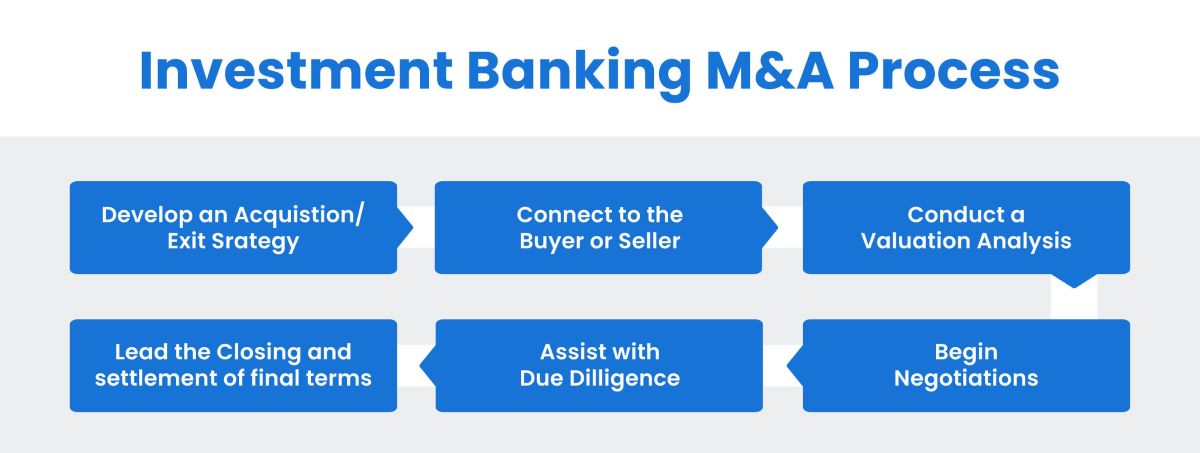

Finance
What Is Underwriting In Investment Banking?
Modified: December 30, 2023
Underwriting plays a crucial role in investment banking as it assesses risks and determines the financial feasibility of a project. Discover the ins and outs of underwriting in the world of finance.
(Many of the links in this article redirect to a specific reviewed product. Your purchase of these products through affiliate links helps to generate commission for LiveWell, at no extra cost. Learn more)
Table of Contents
Introduction
Welcome to the world of investment banking! In this fast-paced and ever-evolving sector, one of the crucial aspects that plays a vital role in raising capital for companies is underwriting. If you are new to the field or simply curious about how investment banks manage to finance various projects, understanding the concept of underwriting is essential.
At its core, underwriting involves assuming the risk of guaranteeing financial support for a company’s securities, such as stocks or bonds, when they are issued to the public. Investment banks, also known as underwriters, play a critical role in this process by assessing the risks associated with securities offerings and setting the terms and conditions under which they will be sold.
Underwriting is a sophisticated practice that requires a deep understanding of financial markets, risk assessment, and regulatory compliance. It serves as a bridge between companies in need of capital and investors looking to deploy their funds. By providing the necessary expertise, underwriters play a critical role in ensuring that the capital-raising process is efficient and transparent.
In this article, we will explore the concept of underwriting in investment banking, its various types, and the important role it plays in financing business operations. We will delve into the underwriting process, the associated fees and compensation, as well as the risks and rewards involved. By gaining a holistic understanding of underwriting, you will gain insights into the inner workings of investment banking and the broader financial ecosystem.
So, whether you are an aspiring investment banker looking to deepen your knowledge or a curious individual seeking to understand the mechanics behind capital raising, let’s dive into the world of underwriting and unlock its significance in investment banking.
Definition of Underwriting
In the realm of investment banking, underwriting refers to the process by which an investment bank assumes the risk of guaranteeing the sale of a company’s securities, such as stocks or bonds, to investors. Underwriters essentially act as financial intermediaries between the issuing company and potential investors.
Underwriting involves a thorough assessment of the financial health of the issuing company, the securities being offered, and the overall market conditions. The goal is to determine the level of risk associated with the securities and set an appropriate price and terms for their sale to the public.
When a company decides to raise capital by issuing securities, it turns to investment banks for assistance. These banks, known as underwriters, analyze the company’s financial statements, market position, growth prospects, and risk profile to evaluate the viability of the securities offering. Based on their analysis, the underwriters help the company structure the offering, including setting the price, quantity, and timing of the securities.
Once the offering terms are determined, the underwriters then commit to purchasing the securities from the issuing company at a predetermined price. In doing so, they assume the risk of selling these securities to investors. The underwriters can either directly sell the securities to investors or create a syndicate, a group of investment banks that collectively distributes the securities to a wider range of investors.
If the underwriters are successful in selling the securities to investors at a price higher than the agreed-upon purchase price from the issuing company, they make a profit known as the underwriting spread. This spread represents the difference between the price at which the underwriters purchased the securities and the price at which they ultimately sell them.
However, if the underwriters are unable to sell the securities at a higher price or at all, they may incur losses. This risk-taking aspect of underwriting is what makes it a critical function within the investment banking industry.
In summary, underwriting is the process of evaluating, pricing, and assuming the risk of selling securities on behalf of a company issuing them. It involves assessing the financial health of the issuing company, setting the offering terms, and either directly selling the securities or distributing them through a syndicate. Underwriters play a pivotal role in facilitating the capital-raising efforts of companies and ensuring that securities offerings are executed efficiently and effectively.
Role of Underwriters in Investment Banking
The role of underwriters in investment banking is multi-faceted and crucial to the entire capital-raising process. They serve as intermediaries between companies and investors, navigating the complexities of the financial markets to ensure successful securities offerings. Let’s explore some of the key roles underwriters play:
- Assessing Risks: Underwriters meticulously evaluate the risk associated with a securities offering. They analyze the financial health of the issuing company, consider market conditions, and assess investor demand. By conducting comprehensive due diligence, underwriters determine the viability of the offering and the potential risk factors.
- Pricing and Structuring: Underwriters help companies determine the appropriate price and terms for their securities. They consider factors such as market demand, comparable securities, and the issuing company’s financials to establish a fair value. By setting the price and structuring the offering, underwriters aim to optimize the chances of a successful sale to investors.
- Marketing and Distribution: Underwriters take on the role of marketing and distributing the securities to potential investors. They leverage their extensive networks and market expertise to generate interest and solicit investment. This involves creating a marketing strategy, conducting roadshows, and liaising with institutional and retail investors to build demand for the securities.
- Managing the Offering: Underwriters oversee the entire process of the securities offering, ensuring compliance with regulatory requirements and coordinating with various parties involved, such as legal teams and auditors. They handle administrative tasks such as documentation, filings, and disclosures, ensuring transparency and regulatory compliance throughout the process.
- Providing Underwriting Commitment: One of the primary responsibilities of underwriters is to provide a commitment to purchase the securities from the issuing company at a predetermined price. This commitment offers a level of reassurance to the issuing company and helps facilitate the financing process.
- Mitigating Risk: Underwriters assume a significant amount of risk when guaranteeing the sale of securities. They carefully manage this risk by diversifying their exposures through syndication, where multiple underwriters collectively distribute the securities to a wider range of investors. This helps mitigate the risk and ensures a broader investor base.
- Facilitating Price Discovery: Underwriters facilitate price discovery by gauging investor demand and establishing the initial offering price. They assess the level of interest from potential investors and fine-tune the pricing to strike a balance between maximizing proceeds for the issuing company and generating investor demand.
The role of underwriters extends beyond the initial offering. They often provide ongoing support and market-making services, ensuring liquidity in the secondary market for the securities they underwrite. This helps investors buy and sell the securities with ease, further enhancing the attractiveness of the offering.
Overall, underwriters are instrumental in facilitating the smooth execution of securities offerings. Their expertise, market knowledge, and risk assessment capabilities are essential in bridging the gap between companies seeking capital and investors looking for opportunities, ensuring a successful and efficient capital-raising process.
Underwriting Process
The underwriting process in investment banking involves several stages, each aimed at evaluating the feasibility of a securities offering and ensuring a successful sale to investors. While specific steps may vary depending on the type of offering and the regulations governing it, the general underwriting process typically includes the following:
- Preliminary Discussions: The process begins with preliminary discussions between the issuing company and underwriters. They engage in detailed conversations to understand the company’s financials, growth prospects, and capital requirements. This enables underwriters to assess the feasibility of the offering and determine their interest in underwriting it.
- Due Diligence: Underwriters conduct a thorough due diligence process to assess the financial health and risk profile of the issuing company. This involves analyzing the company’s financial statements, business operations, competitive landscape, legal and regulatory compliance, and any potential risks or challenges. The goal is to understand the company’s ability to fulfill its obligations to investors.
- Structuring the Offering: Underwriters work closely with the issuing company to structure the securities offering. This includes determining the type and quantity of securities to be issued, establishing pricing mechanisms, and defining any special terms or conditions that may be applicable. The aim is to create an offering that is attractive to investors and aligns with the company’s financing objectives.
- Underwriting Agreement: Once the terms of the offering are established, the underwriters and the issuing company enter into an underwriting agreement. This agreement outlines the specific roles, responsibilities, and obligations of each party, including the underwriters’ commitment to purchase the securities from the issuing company at a specified price.
- Marketing and Investor Roadshows: Underwriters play a crucial role in marketing the securities offering to potential investors. They organize investor roadshows, where they present the investment opportunity to institutional and retail investors. These roadshows provide an opportunity to gauge investor interest and generate demand for the securities.
- Book Building and Allocation: During the marketing process, underwriters build a book of potential investor orders. This book contains details of the investors interested in purchasing the securities and the quantity they are willing to buy. Based on this book, underwriters allocate the securities to investors, considering factors such as investor preference, order size, and regulatory requirements.
- Pricing and Finalizing the Offering: Underwriters determine the final price at which the securities will be offered to investors. This pricing is based on factors such as market conditions, investor demand, and the company’s valuation. Once the pricing is finalized, underwriters communicate the details of the offering to the market, including the final price and the closing date of the offering.
- Sale and Distribution: Underwriters are responsible for distributing the securities to investors. They may directly sell the securities to investors or create a syndicate with other underwriters to collectively distribute the securities. This ensures a wider reach and increases the chances of a successful sale.
- Post-Offering Support: Once the securities offering is complete, underwriters continue to provide support to the issuing company and investors. This includes managing any post-offering obligations, facilitating secondary market trading, and ensuring liquidity for the securities.
The underwriting process requires strong collaboration between the underwriters, the issuing company, legal teams, and regulatory authorities. It involves a rigorous assessment of the issuing company’s financials, structuring the offering, marketing to investors, and ultimately executing the sale. Through their expertise and market knowledge, underwriters play a vital role in ensuring a successful and well-managed securities offering.
Types of Underwriting
Underwriting in investment banking can take on different forms, depending on the nature of the securities being issued and the specific requirements of the company. Here are some common types of underwriting:
- Firm Commitment Underwriting: In firm commitment underwriting, the underwriters commit to purchasing the entire offering from the issuing company at a predetermined price. They assume the risk of reselling the securities to investors. This is the most common type of underwriting and provides certainty to the issuing company regarding the sale of their securities.
- Best Efforts Underwriting: In best efforts underwriting, the underwriters make their best efforts to sell the securities on behalf of the issuing company. However, they do not assume any obligation to purchase any unsold securities. This type of underwriting is typically used for riskier securities or when the market demand is uncertain.
- Standby Underwriting: Standby underwriting is commonly used during rights offerings or when there is a need for additional capital. Under this arrangement, the underwriters commit to purchasing any unsold securities from existing shareholders who do not exercise their rights. This provides a backstop, ensuring that the issuing company raises the desired capital.
- Syndicate Underwriting: Syndicate underwriting involves a group of underwriters collaborating to distribute larger securities offerings. Each member of the syndicate participates in underwriting a portion of the securities and shares the risk and profits accordingly. Syndicate underwriting allows for a broader distribution of the securities and ensures a wider investor reach.
- Competitive Bidding: In competitive bidding underwriting, multiple underwriters submit competitive bids to the issuing company, specifying the terms and conditions under which they are willing to underwrite the securities offering. The issuing company selects the winning bid based on factors such as underwriting fees, pricing, distribution capabilities, and overall expertise.
- Mini-Maxi Underwriting: Mini-maxi underwriting involves setting a minimum and maximum number of securities that need to be sold for the offering to proceed. If the minimum number of securities is not sold, the offering is canceled, and the funds are returned to investors. If the maximum number of securities is sold, the offering is closed. This type of underwriting provides flexibility and allows for adjustments based on investor demand.
These different types of underwriting provide flexibility and options for both the issuing company and the underwriters, allowing them to tailor the underwriting arrangement to their specific needs and circumstances. The choice of underwriting type depends on factors such as the company’s financial position, the type of securities being offered, market conditions, and investor appetite.
It is worth noting that underwriters often combine different types of underwriting methods to suit the requirements of complex securities offerings. The selection of the most suitable underwriting type can have a significant impact on the success of the offering, the cost of capital, and the overall investor interest.
By understanding the various types of underwriting, companies can work closely with underwriters to determine the most appropriate method that aligns with their financing objectives, risk appetite, and market conditions.
Underwriting Fees and Compensation
Underwriting fees and compensation are critical components of the underwriting process in investment banking. They represent the financial reward and compensation that underwriters receive for assuming the risks associated with guaranteeing the sale of securities. Here are some key aspects of underwriting fees and compensation:
Underwriting Spread: The underwriting spread refers to the difference between the price at which the underwriters purchase the securities from the issuing company and the price at which they sell them to investors. It is the primary source of compensation for underwriters. The size of the underwriting spread is influenced by various factors, including the complexity of the offering, market conditions, and the risks involved. Generally, the more risk or effort required to underwrite an offering, the larger the underwriting spread.
Percentage of Offering Size: Underwriters typically charge a percentage fee based on the size of the offering. This fee is a percentage of the gross proceeds raised through the sale of the securities. The underwriting fee is negotiated between the issuing company and the underwriters and can vary depending on the size of the offering, complexity, and market conditions. The fee percentage can range from 1% to 8% of the offering size.
Expense Reimbursement: In addition to underwriting fees, underwriters may also receive reimbursement for various expenses incurred during the underwriting process. These expenses may include legal fees, marketing costs, reporting expenses, and other administrative costs associated with the offering. Expense reimbursements are negotiated upfront and documented in the underwriting agreement.
Over-Allotment Option: Underwriters sometimes have the option to exercise an over-allotment or “greenshoe” option. This grants them the right to sell additional shares of the securities beyond the original offering size. This option allows underwriters to stabilize the price of the securities in the secondary market, and they earn additional compensation from the sale of these additional shares.
Syndicate Compensation: In syndicate underwriting, where multiple underwriters collaborate to distribute the securities, the lead underwriter is responsible for coordinating the efforts of the syndicate members. As compensation for their role, the lead underwriter receives a larger portion of the underwriting spread compared to the other syndicate members. The compensation among the syndicate is typically negotiated and accounted for based on each member’s level of involvement and contribution to the offering.
Non-Financial Benefits: Beyond monetary compensation, underwriters often receive non-financial benefits such as enhanced reputation, increased market visibility, and potential future business opportunities. Successful underwriters establish their expertise, reliability, and credibility in the market, leading to a strong business network and potential recurring business from satisfied clients.
It is important to note that the specific fee structure and compensation arrangement can vary depending on the underwriters, the complexity of the offering, and the prevailing market conditions. These factors are negotiated and documented in the underwriting agreement between the issuing company and the underwriters.
Underwriting fees and compensation are crucial for aligning the interests of the underwriters and the issuing company. They provide an incentive for underwriters to diligently assess risk, market the securities, and orchestrate a successful offering while ensuring a fair return for their efforts and risk-taking.
Risks and Rewards of Underwriting
Underwriting in the field of investment banking comes with both risks and rewards. Understanding these dynamics is essential for underwriters as they evaluate the feasibility of a securities offering and determine their involvement. Here are the key risks and rewards associated with underwriting:
Risks:
- Market Risk: Underwriters face the risk of adverse market conditions, such as a downturn in the economy or a decline in investor appetite for the securities being offered. If the market conditions are unfavorable, underwriters may struggle to sell the securities, leading to potential losses.
- Issuer Risk: Underwriters assume the risk of the issuing company’s performance and ability to meet its financial obligations. If the issuing company experiences financial distress or fails to deliver on its promises, underwriters may face difficulties in selling the securities or may be required to purchase unsold securities, resulting in potential losses.
- Liquidity Risk: Underwriters may face liquidity risk, particularly if they are unable to sell the securities in a timely manner or at favorable prices. If there is a lack of demand from investors, underwriters may be left holding a sizable inventory of securities, which can impact their ability to generate profits and increase their exposure to market fluctuations.
- Legal and Regulatory Risk: Underwriters must adhere to stringent legal and regulatory requirements when underwriting securities offerings. Failure to comply with these obligations may result in legal repercussions, fines, or damage to their reputation. The evolving regulatory landscape can introduce uncertainties and complexities, increasing the potential risk for underwriters.
- Operational Risk: Underwriting involves complex operational processes, including due diligence, marketing, documentation, and distribution of the securities. Errors, technology failures, or inadequate systems and controls can lead to operational risks, impacting the smooth execution of the offering and resulting in financial losses or reputational damage.
Rewards:
- Underwriting Spread: The primary financial reward for underwriters is the underwriting spread. When underwriters successfully sell the securities at a higher price than the purchase price, they earn a profit. The underwriting spread compensates underwriters for assuming the risk and effort involved in guaranteeing and distributing the securities.
- Reputation and Career Enhancement: A successful track record of underwriting can enhance an underwriter’s reputation in the market. It establishes their expertise, reliability, and credibility, leading to potential future business opportunities and career advancement. Building a strong reputation as a trusted underwriter can be a valuable asset in the competitive investment banking industry.
- Relationship Building: Underwriting provides a platform for underwriters to build relationships with issuers, investors, and other market participants. Building strong relationships can lead to recurring business opportunities, such as repeat underwriting mandates, syndication collaborations, and referrals. These relationships can be instrumental in sustaining a successful underwriting business.
- Market Knowledge and Insights: Through the underwriting process, underwriters gain valuable market knowledge and insights into various industries, market trends, and investor sentiments. This knowledge can be utilized in making informed investment decisions, identifying emerging opportunities, and advising clients on their capital-raising strategies.
- Diversification and Syndication Opportunities: Syndicate underwriting allows underwriters to collaborate with other institutions and share the risk and rewards of underwriting larger and more complex securities offerings. Syndication provides opportunities for diversification of risk, enlarging the investor base, and broadening market reach.
Understanding and managing the risks involved in underwriting helps underwriters make informed decisions and implement effective risk mitigation strategies. The potential rewards, both financial and non-financial, highlight the opportunities for underwriters who succeed in navigating the challenges of underwriting and delivering successful securities offerings.
Importance of Underwriting in Investment Banking
Underwriting plays a pivotal role in the world of investment banking, serving as a crucial link between companies seeking capital and investors looking for investment opportunities. The importance of underwriting can be understood from the following perspectives:
- Capital Formation: Underwriting facilitates capital formation by enabling companies to raise funds through securities offerings. By assuming the risk and guaranteeing the sale of securities, underwriters provide the necessary confidence to investors, encouraging them to invest in the company. This capital injection is vital for business expansion, research and development, acquisitions, and other strategic initiatives.
- Market Efficiency: Underwriters contribute to market efficiency by assisting companies in efficiently accessing capital. They provide expertise in structuring the offering, setting the price, and reaching out to a wide range of investors. By efficiently matching the supply of securities with investor demand, underwriters ensure fair pricing, appropriate allocation, and a smooth process of securities issuance.
- Risk Assessment and Mitigation: Underwriters perform extensive due diligence on issuing companies to assess their financial health, risk profile, and growth potential. This risk assessment helps in identifying potential risks and challenges associated with the offering. Through the underwriting process, risks are mitigated by setting appropriate terms, pricing, and allocation strategies that enable investors to make informed investment decisions.
- Investor Protection: Underwriters play a critical role in ensuring investor protection and market integrity. By vetting the issuing company and conducting thorough due diligence, they provide a level of assurance to investors that the offering is based on reliable information. Underwriters also ensure compliance with regulatory requirements, promoting transparency and minimizing the chances of fraudulent activities.
- Market Stabilization: Underwriters help stabilize the market for newly issued securities. By managing the process of allocating securities to investors, underwriters create a broad and diverse investor base. This diversification helps prevent excessive price volatility and provides liquidity to the market, benefitting both the issuing company and investors.
- Advisory Services: Underwriters often provide valuable advisory services to companies seeking capital. They offer insights into market conditions, investor sentiment, and pricing trends. Underwriters help companies with strategic decisions, structuring the offering, and developing effective marketing strategies to maximize investor interest. Their expertise and guidance contribute to successful securities offerings.
- Building Trust and Credibility: Underwriters build trust and credibility in the market through their expertise and reputation. Companies and investors rely on underwriters’ financial acumen, market knowledge, and risk assessment capabilities. By consistently executing successful securities offerings and demonstrating their ability to navigate complex market dynamics, underwriters establish themselves as trusted intermediaries in the capital markets.
Overall, underwriting is a vital function within investment banking, enabling the efficient flow of capital, ensuring investor protection, and fostering market stability. It supports economic growth by facilitating capital formation and providing companies with the necessary funds for expansion and investment. The expertise and risk assessment capabilities of underwriters are crucial in ensuring the transparency, fairness, and efficiency of securities offerings, benefiting both the issuing companies and the investors.
Conclusion
Underwriting is an essential component of investment banking, providing companies with access to capital while ensuring a transparent and efficient securities market. Through their expertise, risk assessment capabilities, and market knowledge, underwriters play a crucial role in facilitating the capital-raising process and protecting the interests of both issuers and investors.
By assuming the risk of guaranteeing the sale of securities, underwriters enable companies to raise the necessary funds for growth, expansion, and strategic initiatives. They conduct thorough due diligence, assess market conditions, and help structure the offering to optimize investor interest and ensure fair pricing.
Beyond their financial contributions, underwriters play a significant role in enhancing market efficiency, promoting investor protection, and preserving market integrity. Through their advisory services, they assist companies in making informed decisions and contribute to the stability of newly issued securities in the market.
The underwriting process involves managing risks and rewards. Underwriters face market, issuer, liquidity, legal, and operational risks. However, the successful execution of securities offerings leads to financial rewards in the form of underwriting spreads, reputation building, and relationship building opportunities.
The importance of underwriting in investment banking cannot be overstated. It promotes capital formation, supports economic growth, and fosters investor confidence. Underwriters ensure that companies can access the necessary capital, while also ensuring that investors have access to transparent information and fair investment opportunities.
In conclusion, underwriting serves as a vital function within investment banking by bridging the gap between companies in need of capital and investors seeking opportunities. Through their expertise, risk assessment, and market knowledge, underwriters contribute to the growth and stability of the capital markets, ultimately benefiting the economy as a whole.














